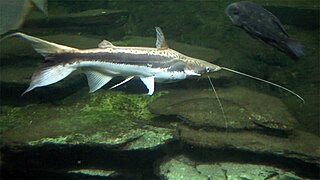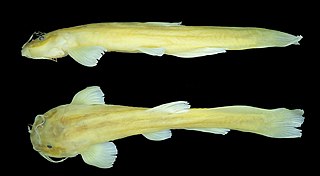Vandellia is a genus of catfishes native to South America. The species in this genus are the most well-known of the parasitic catfishes also known as candiru, known for their alleged habit of entering the human urethra.
Listrura is a genus of pencil catfishes native to South America.
Myersglanis is a genus of sisorid catfishes native to Asia.

Sorubim is a small genus of long-whiskered catfish native to tropical South America. A number of characteristics allows the differentiation of each species in the genus. Sorubim species are important food fish in South America and are highly significant to fisheries of some areas; however, harvests of these fish are not identified as much as other, more popular food fishes such as Colossoma, Arapaima, and Brachyplatystoma. Some species of this family are popular aquarium fish.

Platysilurus is a genus of long-whiskered catfishes native to South America.
Miuroglanis platycephalus is a species of catfish of the family Trichomycteridae, and the only species of the genus Miuroglanis. This species is endemic to Brazil where it occurs in the Solimões River basin. This species grows to a length of 1.2 centimetres (0.47 in) NG.
Tridensimilis is a genus of pencil catfishes native to South America.
Paravandellia is a genus of pencil catfishes native to South America.
Plectrochilus is a genus of pencil catfishes native to South America.

Copionodon is a genus of catfishes of the family Trichomycteridae. It includes three species, C. lianae, C. orthiocarinatus, and C. pecten.
Tridentopsis is a genus of pencil catfishes native to South America.

Bagarius is an Asian genus of catfishes of the family Sisoridae. It includes five to six extant species and potentially one extinct fossil species, B. gigas.

Gagata is a genus of sisorid catfishes native to Asia.
Pseudostegophilus is a genus of pencil catfishes native to rivers in tropical South America. The members of this genus are obligate parasites that feed on scales and mucus of other fish.
Parastegophilus is a genus of pencil catfishes native to South America.
Schultzichthys is a genus of pencil catfishes native to South America.
Parakysis is a genus of catfishes of the family Akysidae. It includes six species.
Ochmacanthus is a genus of pencil catfishes native to South America. These species are distributed in South America. O. alternus and O. orinoco originate from the Rio Negro and Orinoco River basins of Brazil and Venezuela. O. batrachstoma inhabits the Paraguay River basin in Brazil. O. flabelliferus lives in river drainages in Guyana and Venezuela. O. reinhardtii is known from the Amazon River basin in Brazil and drainages in French Guiana.

Henonemus is a genus of pencil catfishes native to South America.

Belodontichthys is a genus of sheatfishes native to Asia.






